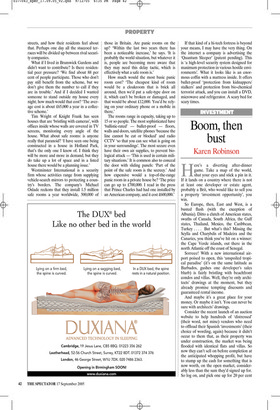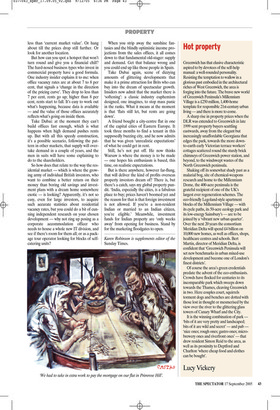Boom, then bust
Karen Robinson
Here’s a diverting after-dinner game. Take a map of the world, shut your eyes and stick a pin in it. If it lands on a country where there is not at least one developer or estate agent, probably a Brit, who would like to sell you a property ‘investment opportunity’, you win.
So Europe, then, East and West, is a busted flush (with the exception of Albania). Ditto a clutch of American states, swaths of Canada, South Africa, the Gulf states, Thailand, Mexico, the Caribbean, Turkey .... But what’s this? Missing the Scylla and Charybdis of Madeira and the Canaries, you think you’ve hit on a winner: the Cape Verde islands, out there in the north Atlantic off the coast of Senegal.
Sorreee! With a new international airport poised to open, this ‘unspoiled tropical paradise’ (it’s on the same latitude as Barbados, gushes one developer’s sales blurb) is fairly bristling with beachfront condos and villas. Well, they’re only architects’ drawings at the moment, but they already promise tempting discounts and guaranteed rental income.
And maybe it’s a great place for your money. Or maybe it isn’t. You can never be sure with architects’ drawings.
Consider the recent launch of an auction website to help hundreds of ‘distressed’ (their word, not mine) vendors who need to offload their Spanish ‘investments’ (their choice of wording, again) because it didn’t occur to them that, as their property was under construction, the market was being flooded with identical flats and villas. So now they can’t sell on before completion at the anticipated whopping profit, but have to stump up the cash for something that is now worth, on the open market, considerably less than the sum they’d signed up for. So log on, and pick one up for 20 per cent less than ‘current market value’. Or hang about till the prices drop still further. Or look for another location.
But how can you spot a hotspot that won’t turn round and give you a financial chill? The hard-nosed business types who invest in commercial property have a good formula. One industry insider explains it to me: when office vacancy rates are at about 7 to 8 per cent, that signals a ‘change in the direction of the pricing curve’. They drop to less than 7 per cent, rents go up; higher than 8 per cent, rents start to fall. It’s easy to work out what’s happening, because data is available — and the value of those offices accurately reflects what’s going on inside them.
Take Dubai: at the moment they can’t build offices fast enough, which is what happens when high demand pushes rents up. But with all this speedy construction, it’s a possible scenario, following the pattern in other markets, that supply will overtake demand in a couple of years, and the men in suits will have some explaining to do to the shareholders.
So how does that relate to the way the residential market — which is where the growing army of individual British investors, who want to combine a better return on their money than boring old savings and investment plans with a dream home somewhere exotic — is looking? Apparently, it’s not so easy, even for large investors, to acquire such accurate statistics about residential vacancy rates, but you could do a bit of cunning independent research on your chosen development — why not ring up posing as a corporate accommodation officer who needs to house a whole new IT division, and see if there’s room for them all; or as a package tour operator looking for blocks of selfcatering units? When you strip away the sunshine fantasies and the blindly optimistic income projections from the sales offices, it all comes down to that fundamental old-stager: supply and demand. Get that balance wrong and you could end up like those people in Spain.
Take Dubai again, scene of dizzying amounts of glittering developments that make it a prime attraction for Brits who can buy into the dream of spectacular growth. Insiders now admit that the market there is ‘softening’: a classic industry euphemism designed, one imagines, to stop mass panic in the ranks. What it means at the moment is that ‘flats still let, but rents are going down’.
A friend bought a city-centre flat in one of the capital cities of Eastern Europe. It took three months to find a tenant in this supposedly buzzing city, and he now admits that he was given ‘unrealistic expectations’ of what he could get in rent.
Still, he’s not put off. He now thinks Warsaw is where the money is to be made — one hopes his enthusiasm is based, this time, on realistic expectations.
But is there anywhere, however far-flung, that will deliver the kind of profits overseas property investors dream of? There is, but there’s a catch, says my global property pundit. ‘India, especially the cities, is a fabulous place to buy; prices haven’t boomed yet and the reason for that is that foreign investment is not allowed. If you’re a non-resident Indian or married to an Indian citizen, you’re eligible.’ Meanwhile, investment funds for Indian property are ‘only weeks away’ from opening for business. Stand by for the marketing floodgates to open.




















































 Previous page
Previous page